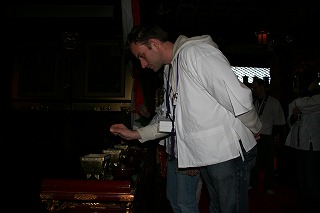Thinking About The Shikoku Pilgrimage
About 1200 years ago when the monk Kukai returned to Japan after spending many years in China, he found his home country in disarray. Great political tensions filled the land, and with it favor over certain religions changed as swiftly as did the Emperors. Three different men took on the title of Emperor in the three years after Kukai's arrival. Taking an official court position in 809AD, Kukai spent the rest of his life writing enormously influential works on Shingon Buddhism and leading the establishment of a monastery community on Mount Koya in Wakayama Prefecture. The Koya-san community became the heart of the Shingon Buddhism movement, and over a millennium later it is recognized as a treasure of human creation. Koya-san drew monks from across Japan to study the lessons of Kukai. Following the death of Kukai, he was anointed with the name Kobo Daishi, meaning "Great Saint."
About 1200 years ago when the monk Kukai returned to Japan after spending many years in China, he found his home country in disarray. Great political tensions filled the land, and with it favor over certain religions changed as swiftly as did the Emperors. Three different men took on the title of Emperor in the three years after Kukai's arrival. Taking an official court position in 809AD, Kukai spent the rest of his life writing enormously influential works on Shingon Buddhism and leading the establishment of a monastery community on Mount Koya in Wakayama Prefecture. The Koya-san community became the heart of the Shingon Buddhism movement, and over a millennium later it is recognized as a treasure of human creation. Koya-san drew monks from across Japan to study the lessons of Kukai. Following the death of Kukai, he was anointed with the name Kobo Daishi, meaning "Great Saint."
Over the next millennium, myth and truth intertwined to make a legend of Kobo Daishi, particularly in his birthplace on the island of Shikoku. Local stories developed of Kobo Daishi throwing himself from a cliff to test his beliefs in Buddhism and of establishing a temple on the Yashima plateau after taking directions from a tanuki--a local raccoon dog of legend. These stories might well be placed with America's tales of the Wild West. Here is a land unconquered, the island of Shikoku, distant but not forgotten by the Emperors on the mainland. The setting was ripe for the emergence of a character of epic scale. Tales were created of Kobo Daishi wandering the countryside with a staff the height of his body, jingling as pieces of metal dangled from it. According to stories, he wandered the island of Shikoku, spreading his religion by visiting established temples and founding new ones. In the 17th century, a circuit of 88 temples across the island of Shikoku was codified as the official pilgrimage trek. People were told that in life Kukai had walked this path and visited all of these temples, and that his spirit could still be found traveling in the guise of pilgrim, helping others as they worked their way across the island of Shikoku. It was said that to walk the circuit was to walk with Kukai. No traveler would ever be alone.
Most modern sources agree that Kobo Daishi made no such journey during his life. Kobo Daishi's own writings only reference two of the 88 temples in question, one of them being his own birthplace in the town of Zentsuji in Kagawa prefecture. To put it directly, the idea of walking in Kukai's footsteps is an idea rooted in local myth.
Regardless of its roots, however, this pilgrimage has served to do something that few if any other localized journeys in the world have done, and that is to relive the past. The temples included in the circuit, some dating back to the life of Kobo Daishi, have been kept in pristine condition. Perhaps most importantly, these well-kept temples are unique examples of local beliefs. They stand in stark contrast to the elaborate grounds and pagodas of Kiyomizudera in Kyoto or Todai-ji and its Daibutsu in Nara, developed over long periods of time with the money of Emperors and designed to be shown to the world. The preserved temples of the Shikoku pilgrimage are modest and almost mundane, examples of how temples were established, run, and preserved on local money and resources.
In the myth of Kobo Daishi, the Shikoku pilgrimage found possibly the best way to attract people from around Japan, and now from around the world, to experience the local culture. Pilgrims did their best to emulate the old world. They practiced Buddhist asceticism, learned the mantras and sutras, traveled on foot and borrowed money and food from others, and of course, spent their time learning and traveling the localities of Shikoku. The appeal of the pilgrimage traveled overseas and now several thousand foreigners partake in the circuit each year, taking in the culture and sights of Shikoku while themselves trying to emulate an older world.
Put simply, the Shikoku temple pilgrimage is an utterly unique experience that, despite its roots in myth, has managed not only to preserve ancient buildings but intrigued people to learn about and re-enact a foreign way of life. The temples are truly the heritage of the people of Shikoku, and what they did was find a way to share their culture and values with the world, and they've succeeded. Each year, over a hundred thousand people take the challenge of the Shikoku pilgrimage, and there seems to be no end in sight to the continuous stream of pilgrims from around the world.

